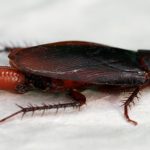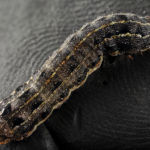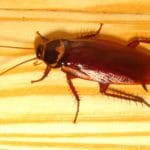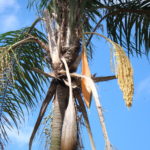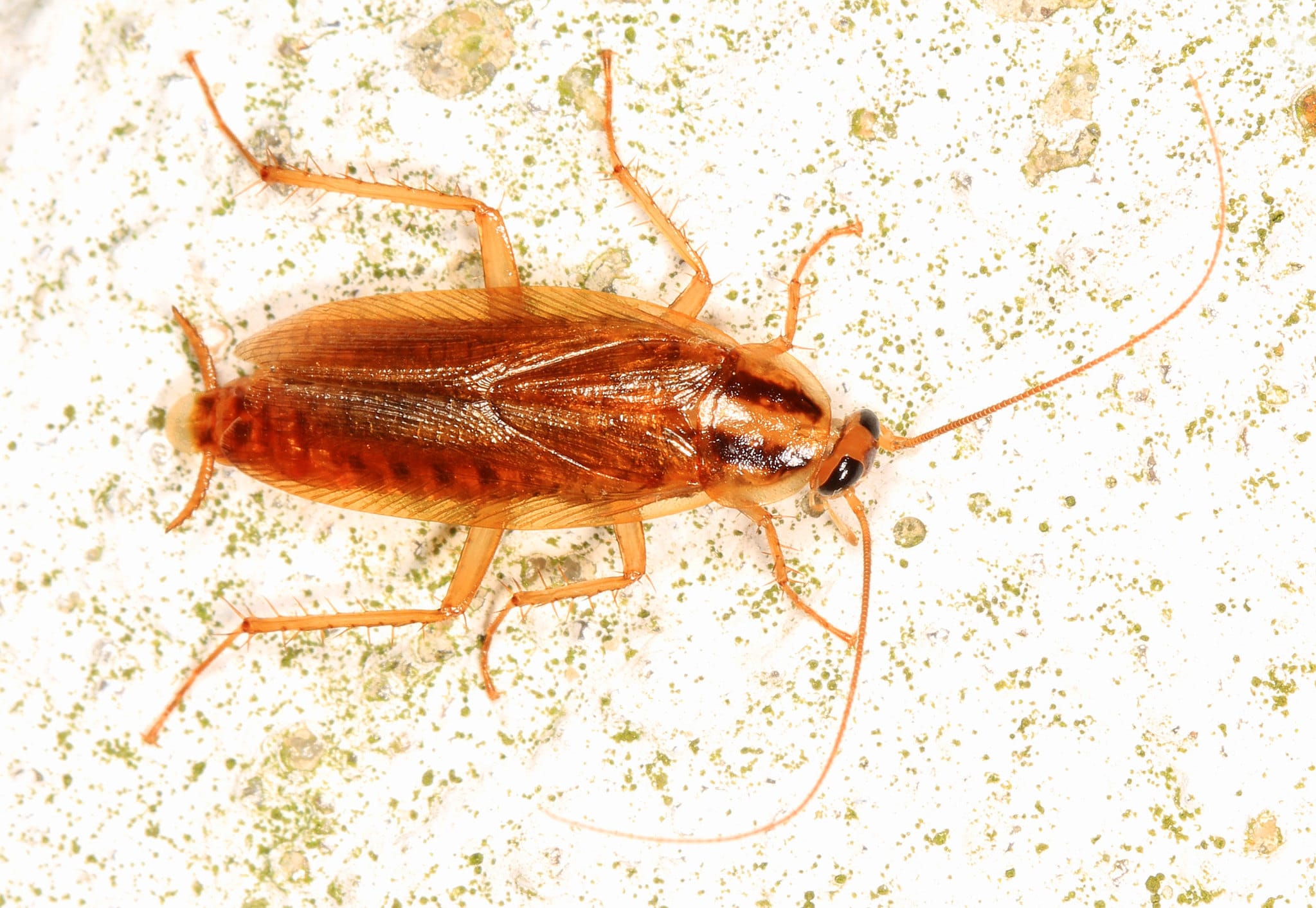
Whether your new Orlando home is newly constructed or preowned, multiple pests may call the residence “home sweet home” too. With its year-round warm temperatures, subtropical climate and humidity, Florida, including Orlando is one of the buggiest locations in the United States. Below we’ve outlined some of the most-common Orlando pests you’re likely to encounter in your new home, as well as signs of a problem and what you can do to make your new home pest-free.
Cockroaches
If there were awards for the most revolting and nauseating pest, cockroaches would probably win. No matter how new the residence is or how clean you keep house, it’s not uncommon to spy a roach scurrying across the floor some night.
The typical roach you’ll find in your Orlando home are brown and can be over an inch long. Most common types found indoors are German cockroaches, the American cockroach and Asian and Oriental cockroaches. However, outdoors usually in mulch and vegetative debris, you’ll find the Wood roach.
Roaches enter the home through paper packaging, garages, drain pipes, vents and not properly sealed doors and windows. The pests are nocturnal, so the only time you’re likely to know you have a roach problem is when you turn on a lights at night.
Other signs of cockroaches include:
- Brown smear marks on walls.
- Cockroaches shed their nymphal skin.
- Unpleasant musty odor on items they’ve come in contact with.
Cockroach Prevention & Treatment
Below are various things you can do to prevent a cockroach infestation and treatment options:
- Seal any possible entry points like around windows, doors, plumbing fixtures and any cracks or openings leading into the house.
- Keep any crumbs or food residues cleaned up, pick up pet food and store away at night.
- You can find bait stations and insecticidal treatments at your local home improvement store.
- Call in a pest-control specialist if the infestation is severe.
Ants
Ants hold the honor of being the No. 1 pest in the United States and can infest inside and outside of the home. Inside it’s easy to see you have an ant problem, as you generally see the tiny pests scurrying over countertops, floors or walls. Outside, you can see the ants leaving a trail back to their mound.
Common Indoor Ants
It’s not uncommon for ants to enter your Orlando home through windows, doors or other openings. Common indoor ants include odorous, pharaoh and carpenter, with carpenter ants creating the most problems.
- Odorous Ants: Odorous ants are primarily a nuisance and don’t cause structural damage. They get their common name from the odor they produce when smashed. Small, typically around 1/8 inch long and black or brown, the ants are usually found around moisture and have a sweet tooth. They don’t bite but can be hard to control.
- Pharaoh Ants: Pharaoh ants are around 1/16 inch long and pale yellow or red with darker abdomens. They aren’t fussy when it comes to food and can be difficult to control. Additionally, they don’t bite or cause structural damage but can spread disease.
- Carpenter Ants: Carpenter ants are around 5/8 inch long and with bodies colored in black, red or a combination of both colors. They can cause structural damage, as they build nests in dead, wet or hollow wood. The ants bite and homeowners may need to call in a professional for complete control.
Indoor Ant Prevention & Treatment
Options to help prevent and treat an indoor ant infestation include:
- Make sure to wipe up any food or drink debris and keeping food in tightly sealed containers.
- Seal any entry points allowing the ants to get inside the home.
- Set up bait stations and treat infected area with insecticides.
- Call in a pest-control specialist.
Common Outdoor Ants
Although Florida is home to a wealth of different ant species, the two most common ants you’re likely to run into at your Orlando residence are fire ants and pavement ants.
- Fire Ants: Fire ants are reddish to black with copper heads and around 5 mm long, with an aggressive and biting nature. Dome-shaped mounds are found in sunny areas of the yard and can be 2-feet in diameter, containing one queen and thousands of fire ants.
- Pavement Ants: Pavement ants are dark brown and have small stingers. They typically build their mounding nest along cracks in sidewalks and driveways, along the home’s foundation and bricks, as well as in woodpiles and mulch.
Outdoor Ant Treatment Options
If you notice ant mounds outdoors around your home and yard, you can use insecticidal granules designed specifically for ants to kill the pests. If you have a large problem or the granules don’t seem to be working, it’s probably best call in a pest-control professional to treat the ant problem.
Spiders
Although most spiders you find inside your Orlando home are harmless and actually eat bugs, they still aren’t welcome houseguests. Even though most are harmless, you need to be able to recognize the two venomous types that are most likely to invade your home: the black widow and brown recluse. Nonvenomous spiders you might find are daddy longlegs and the domestic house spider
- Black Widow: Black widow spiders are around 1.5 inches long, shiny black and have the distinctive red hourglass shape on the bottom of their abdomens. The spider resides in crawlspaces, woodpiles, garages, outdoor sheds and stone walls.
- Brown Recluse: Brown recluse spiders are small and only around 1/2 inch long. They are brown and have a violin-shaped marking on their backs. They are typically found in outdoor sheds, dressers, wooden furniture and cardboard boxes.
- Daddy Longlegs: Daddy long leg spiders have long, thin legs and don’t look like they have a body attached to them. They are light brown and found on ceilings, room corners, crawlspaces, windows and doors.
- Domestic House Spider: A large spider at almost 2 inches, grayish-brown and with various markings. They are usually found in storage and undisturbed rooms, the corner of cupboards and behind furniture.
Spider Prevention & Treatment
Even if nonvenomous, if allowing spiders to reside inside your home isn’t your cup of tea, fortunately, you have options for prevention and treatment.
- Knock down any spider webs you find inside or outside your home.
- Seal any entranceways into the home.
- Use an insecticide specific to spiders to kill any inside the home.
- Call in a pest-control specialist if the problem is large or DIY methods aren’t controlling the problem.
Fleas
The only time you’re going to have to worry about fleas in your new Orlando home is if it was preowned by someone who owned pets. A sure way to know if you have a flea problem is if you start noticing your pet scratching and biting and then you start feeling the tiny pest biting at your ankles.
Treating a flea problem is a three-pronged attack to gain control. You’ll need to treat the yard, home and pet to eradicate completely the problem. For the best results, you need to treat a flea problem as soon as you notice it.
Flea Prevention & Treatment
- Thoroughly vacuum the house to pick up fleas, flea eggs and pupae.
- Treat the affected inside area with a product labeled for use on indoor flea problems.
- Wash the pet to remove fleas and place on a flea prevention program.
- Treat outdoor areas with a product labeled for use on outdoor flea problems.
- Call in a pest-control specialist if DIY methods aren’t working.
Termites
The last thing a new homeowner in Orlando or any location in the U.S. wants to hear is they have a termite problem. According to World Wide Pest Control, Inc. and due to the consistently warm and humid weather, Orlando ranks as one of the 15 cities that are most termite-infested.
Termites love wood and can cause significant damage to wooden fencing, structures and homes, as well as wooden furniture. Subterranean termites reside in the ground, making their way into the wooden home where it touches the ground. They also get inside the house through tunnelways made in cracks in the foundation.
Signs of a Termite Problem
- Suddenly seeing a swarm of winged ant-like insects around your home.
- Hollow sound when wood is tapped.
- Mud tubes on outside walls, in crawlspaces and on wooden beams.
- Castoff swarmer wings.
Termite Treatment and Prevention
If all the signs point to you having a potential problem with a termite infestation inside your new home, the best course of action is to call in a pest-control specialist. Time is of the essence when it comes to ridding your home of termites, so it’s a job best left for the professionals.
Home Sweet Pest-Free Home
There are plenty of things you can do to keep your new Orlando home pest-free like keeping the indoors and outside clean, as well as repairing any potential entranceways and treating problems as they occur. However, for large infestations of pests that can damage your home’s structure, it’s best to let the pros handle the situation.
Main image credit: German cockroach, Judy Gallagher, CC 2.0
